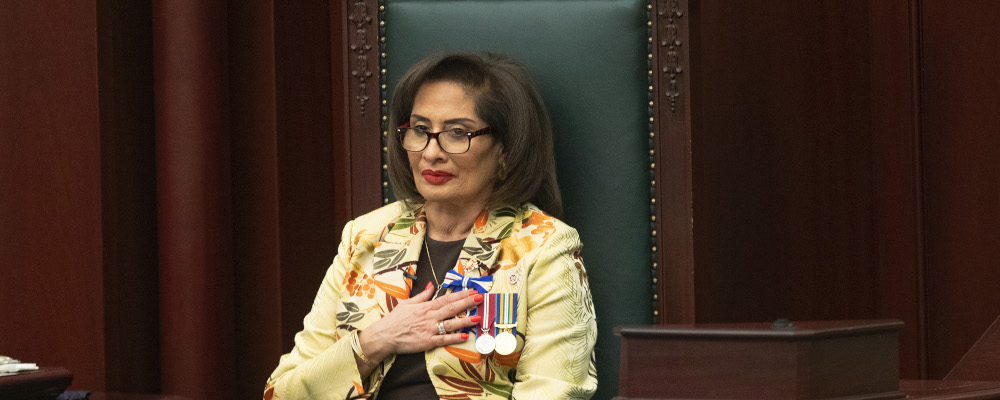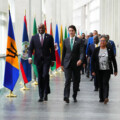There are many different, broadly right-wing factions in Canada; however, most of them have a comparatively minor influence on the public scene. This piece tries to get beyond the “centrism vs. populism” debate that is the main focus of conservative debates today
The federal Conservative party has often had ultra-moderates or centrists or Red Tories exerting the most influence on it. The term “small-c conservative” arose in Canada because of the fact that the Progressive Conservative party, or “big-C” Conservatives, had almost entirely abandoned conservatism, especially under the so-called strong leadership of Brian Mulroney. In the 1980s, more ideological conservatives were often derided as “cashew conservatives”, and Mulroney had snidely declared that all the ideological conservatives in Canada could fit into a telephone booth.
It could be argued that paleoconservatives“Paleoconservatives support restrictions on immigration, decentralization, trade tariffs and protectionism, economic nationalism, isolationism, and a return to traditional conservative ideals relating to gender, culture, and society.” https://en.wikipedia.org/wiki/Paleoconservatism#:~:text=Paleoconservatives%20support%20restrictions%20on%20immigration,gender%2C%20culture%2C%20and%20society. and social conservatives, united by the principles of upholding traditional nation, family, and religion, as well as a real work-ethic and strict law and order, do indeed have much in common. These two similar outlooks are clearly comparatively weak in Canada.
As for the opposition to capitalism and globalization, there indeed paleoconservatives differ from most modern-day conservatives. However, it could be argued that the exaltation of globalization, internationalism, and capitalism, has grown increasingly prominent among the more generalized right-wing as a result of the ascendancy of the neoconservatives. Surely, social conservatives are also aware of many negative aspects of capitalism. Most of the mass-media cultural industries often criticized by social conservatives (for example, Hollywood, television, advertising, rock and rap music, pornography) usually operate on a strictly free-market, for-profit basis. And the huge, bureaucratic, transnational—and now increasingly woke—corporations can simply be seen as part of the so-called “managerial-therapeutic regime” that is socially liberal and economically conservative and which is at war with what social conservatives esteem.
Regardless of their comparative weakness in Canada today, the outlooks of paleoconservatives and social conservatives are clearly not coterminous with those of neoconservatives, libertarians, or Red Tories. To paleoconservatives, neoconservatives are gung-ho capitalists who disdain the true common good, libertarians are libertines, and Red Tories are seen as opportunists within the Conservative party who have largely adopted left-liberal outlooks.
Admittedly, the term “Red Tory” can certainly have a more elevated meaning, as in the thought of Canadian traditionalist philosopher George Parkin Grant (1918-1988)“An extraordinary public communicator, his first book, Philosophy in the Mass Age(1959), began as a series of CBC lectures. In it he posed the question of how human beings could reconcile moral freedom with acceptance of the view that an order existed in the universe beyond space and time. In 1965, furious that the Liberal government had accepted nuclear weapons, he published LAMENT FOR A NATION. This short work created a sensation with its argument that Canada was destined to disappear into a universal and homogeneous state whose centre was the United States.” https://www.thecanadianencyclopedia.ca/en/article/george-grant where it becomes what could be called a “social conservatism of the Left”—but on the other hand, it can also be used to describe some of the opportunist party activists of the Progressive Conservative camp who had earlier inveighed against the supposed bigotry of the Reform Party.“The Reform Party was a right-wing, populist, western political protest movement that grew to become the official opposition in Parliament in 1997. Reform played a role in the creation of the Canadian Alliance, as well as the demise of the federal Progressive Conservative Party — and the eventual merger of those two groups into today’s Conservative Party.” https://www.thecanadianencyclopedia.ca/en/article/reform-party-of-canada
It cannot be expected that the paleoconservatives’ and social conservatives’ distinct identity is to be entirely melded with and into neoconservatism, libertarianism, or Red Toryism. For example, because of their appreciation for “the truly social,” paleoconservatives and social conservatives are unlikely to unqualifiedly embrace capitalism. The desire for upholding some kind of “true Tory” welfare state in Canada would, in fact, also be more popular than the economically strident but socially flaccid outlooks of many free-market boosters. Paleoconservatives should also be able to see much that is worthwhile in the passionate attachment of the Quebecois nationalists to Quebec, and in their visceral disdain for federal state centralism.
Paleoconservative and social conservative philosophical outlooks, despite their reputation of obdurate reaction, contain within them aspects that allow for some degree of coalition building with various other outlooks—some of them perhaps unexpected, such as ecology or trade-unionism.
It may be that trying to solidly define oneself, and engage in reflective thought as to what one represents, is more conducive to true coalition-building than the attempt to embrace everything. The sensitivity of paleoconservatism and social conservatism to “the truly social” mentioned above offers a certain nuance to their views that is lacking in the usual neoconservative boosterism of unrestricted capitalism and unlimited technology as a panacea.
There are many aspects of capitalism today that are harsh and ugly. And profound concern for the environment should not be written off as tree-hugging lunacy. At the same time, paleoconservatives and social conservatives resist the dogmas of political correctness and do not wish to be associated with those tendencies in “the official Right” (typified by Canadian Red Tories, many neoconservatives, and some libertarians) that heavily defer to these.
Paleoconservatives and social conservatives are very likely to remain in critical opposition to the so-called late modern society. However, some of their critiques might begin to have an impact on the thoughts and actions of a significant number of people. It could be argued that keeping one’s outlook in coherent, uncompromised existence makes it far more likely that, at some point, it will indeed influence people’s hearts and minds, which might then lead to substantial shifts in public policy.
Recommended for You

Ginny Roth: J.D. Vance, Pierre Poilievre, and how they slice their economic pie

David Polansky: As President Biden leaves the race, will the Democratic Party hodgepodge hold?

RCMP spending to protect MPs may have risen 112% since 2018, as Canadian politicians face greater rise in threats

Trevor Tombe: Canadians are paying billions in hidden taxes on new homes









